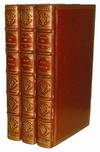
A Chart Shewing the North West Passage Discovered by Capt. R. le M. McClure: The first man to traverse the Northwest Passage H.M. Ship Investigator; also the Coast Explored in Search of Sir J. Franklin, by Sir Jas. Ross 1848 & 9... Capt. Sir Edwd. Belcher 1852 & 53... by E.A. Inglefield, Commander H.M.S. Phoenix.
by FAWEKNER, W. H
- Used
- Condition
- See description
- Seller
-
London, United Kingdom
Payment Methods Accepted
About This Item
London,: Hydrographic Office, Admiralty,, 14 October 1853.. 475 by 945mm (18.75 by 37.25 inches).. Lithograph chart, manuscript inscription upper left, mounted on linen, Admiralty stamp below title, stain above title, a few minor tears to margins skilfully repaired, loss to lower right corner repaired not affecting image. This is the first chart to show McClure's ground-breaking discovery of the North-West Passage. Travelling on board the Investigator in 1850, Robert McClure led one of the many expeditions launched in search of explorer James Franklin, who had become trapped in the Arctic while searching for the seaway linking the Atlantic and Pacific Oceans. In doing so, McClure himself became the first man credited with navigating the North-West Passage, although he made much of his journey over ice rather than by sea, his path represented on this chart by a solid line. Passing through the Bering Strait (here labelled Behring's Strait), McClure discovered and named the even narrower Prince of Wales Strait. The line showing the Investigator's journey ends abruptly at the North-West promontory of Baring Island, where the ship was frozen for the winter. And so, the men set up their winter quarters for 1850 on the ship, where they took part in English and maths lessons, hunted musk oxen and even performed plays. After circumnavigating Baring Island in the latter half of 1851, the Investigator was once again forced to stop by the ice, passing the next six months at Mercy Bay, here said to be "abounding with reindeer" which kept the crew alive throughout the harsh winter. McClure subsequently undertook an expedition to Melville Island by sledge, and although his small team travelled for 26 days, they failed to reach the island and returned to their still-frozen ship. The following winter, with the health and strength of the crew greatly deteriorated, McClure made the decision to abandon the Investigator, and travel over the ice to seek help from other ships, their route marked by a dotted line on the chart. Reaching Beechey Island in May 1853, the men were met by the H.M.S. Phoenix, captained by Inglefield, on which they returned to Britain. Although Inglefield had not succeeded in his original mission to rescue Franklin, he did return McClure's crew to safety, and was subsequently able to make this chart of the newly-discovered North-West Passage, the first hydrographic representation of the area. Although he produced many watercolour paintings of the Arctic landscapes and wrote a book recounting his expedition, Inglefield himself was not responsible for the drafting of this map, which was drawn by W.H. Fawekner, Second Master aboard the Phoenix, and published by John and Charles Walker. Fawekner has also included a list of all previous voyages to the area, which were sent by the Admiralty to search for Franklin, these included: Sir James Ross (1848-1849); Sir John Richardson (1848-49); Captain Austin (1850); Mr Penny (1850); Mr Rae (1851); Mr Kennedy and M. Bellot (1852); Captain Ingelfield (1852-1853); Captain Sir Edward Belcher (1852-1853). The voyages are clearly marked on the map, with hatchured lines to the coast denoting each voayge's extent. To the upper left of the present example is a hand-written dedication by the Captain Inglefield to Bobbington School. Rare we have been able to trace only three institutional examples of this chart, held at the National Maritime Museum, the University of Queensland and the University of Alaska Fairbanks.
Reviews
(Log in or Create an Account first!)
Details
- Bookseller
- Daniel Crouch Rare Books Ltd
(GB)
- Bookseller's Inventory #
- 13006
- Title
- A Chart Shewing the North West Passage Discovered by Capt. R. le M. McClure
- Author
- FAWEKNER, W. H
- Book Condition
- Used
- Publisher
- Hydrographic Office, Admiralty,
- Place of Publication
- London,
- Date Published
- 14 October 1853.
- Product_type
- Maps
- Size
- 475 by 945mm (18.75 by 37.25 inches).
Terms of Sale
Daniel Crouch Rare Books Ltd
Any item may be returned if you are not happy with it providing we are notified within 7 days of your receiving it. This does not affect any statutory rights you may have under UK or EU law for returning the item outside this period. All we ask is that you return the item(s) by the same or similar method to that in which they were sent to you. Your postage costs and any payment already received will be refunded immediately on our receipt of the items in the same condition as you received them.
About the Seller
Daniel Crouch Rare Books Ltd
Biblio member since 2018
London
About Daniel Crouch Rare Books Ltd
Daniel Crouch Rare Books is specialist dealer in antique atlases, maps, plans, sea charts and voyages dating from the fifteenth to the nineteenth centuries. Our carefully selected stock also includes a number of fine prints and globes, and a selection of cartographic reference books.Our particular passions include rare atlases, wall maps, and separately published maps and charts. We strive to acquire unusual and quirky maps that are in fine condition. We are members of the following trade associations: The Antiquarian Bookseller's Association (ABA); The British Antique Dealers' Association (BADA); Confédération Internationale des Négociantes en Oeuvres d'Art (CINOA); The International League of Antiquarian Booksellers (ILAB); The Society of London Art Dealers (SLAD); and The European Fine Art Foundation (TEFAF). Daniel and Nick are also both members of The Company of Art Scholars, Dealers, and Collectors.
Glossary
Some terminology that may be used in this description includes:


